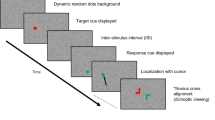Abstract
In the subjective measurement of fixation disparity (FD), the subject fuses contours presented in the peripheral macular areas of both eyes (fusion lock). The position of the eyes relative to each other is monitored by means of two haploscopically seen vertical lines presented in the central macular area, one above and one below a binocularly seen horizontal line. The subject is instructed to shift one of the vertical lines horizontally until the two are aligned, while fixating their intersection with the horizontal line. It has recently been questioned whether the foveolae really are pointed towards the perceived intersection. In this study, we monitored the position of one eye while intermittently covering the fellow eye, while the subject maintained fixation of the intersection of the remaining vertical line and the horizontal line. We found slight differences in position of the measured eye, depending on whether the other eye was covered or not, i.e. depending on the presence or absence of fusion in the macular periphery. These differences were more pronounced in the non-dominant eye.
Similar content being viewed by others
References
Panum PL. In: Untersuchungen über das Sehen mit zwei Augen. Kiel, 1858.
Schor CM. The influence of rapid prism adaptation upon fixation disparity. Vis Res 1979; 19: 757–765.
Schor CM. Fixation disparity: a steady state error of disparity-induced vergence. Am J Opt & Physiol Optics 1980; 57: 618–631.
Ogle KN, Mussey F, Prangen A de H. Fixation disparity and the fusional processes in single binocular vision. Am J Ophthalmol 1949; 32: 1069–1087.
Ogle KN. In: Researches in binocular vision. Philadelphia: WB Saunders, 1950.
Ogel KN, Prangen A de H. (1951) Further considerations of fixation disparity and the binocular fusional processes. Am J Ophthalmol 1951; 34: 57–72.
Ogle KN, Martens TG, Dyer JA. In: Oculomotor imbalance in binocular vision and fixation disparity. Philadelphia: Lea & Febiger, 1967.
Jampolsky A. Esotropia and convergent fixation disparity. Am J Ophthalmol 1956; 41: 825–833.
Jampolsky A, Flom BC, Freid AN. Fixation disparity in relation to heterophoria. Am J Ophthalmol 1957; 43: 97–106.
Crone RA. A new theory about heterophoria. Ophthalmologica 1971; 162: 199–206.
Palmer EA, von Noorden GK. The relationship between fixation disparity and heterophoria. Am J Ophthalmol 1978; 86: 172–175.
Haase HJ. Fixationsdisparation: Eine erweiterte Theorie und praktische Folgerungen. Der Augenoptiker 1980; 3: 1–9.
Pestalozzi D. Über die Behandlung von heterophoren Legasthenikern mit Fixationsdisparation mittels Prismenvollkorrektion. Klin Mbl Augenh 1986; 188: 471–473.
Hebbard FW. Comparison of subjective and objective measurements of fixation disparity. J Opt Soc America 1962; 52: 706–712.
Kertesz AE, Hampton DR, Sabrin HW. The unreliability of nonius line estimates of vertical fusional vergence performance (letter). Vis Res 1983; 23: 295–297.
Kertesz AE, Lee HJ. The nature of sensory compensation during fusional response. Vis Res 1988; 28: 313–322.
Schor CM, Wesson M, Robertson KM. Combined effects of spatial frequency and retinal eccentricity upon fixation disparity. Am J Opt & Physiol Optics 1986; 63: 619–626.
Irving EL, Robertson KM. Monocular components of fixation disparity: the effects of monocular image degradation. Invest Ophthalmol 1990; 31 (ARVO Supplement): 95.
Bourdy C, Cottin-Lemerle F. La disparité de fixation: variations des composantes monoculaires en fonction de la distance d'observation. Annales Oculist (Paris) 1971; 204: 697–730.
de Decker W, Scheffel T. Simultaneous investigation of fixation disparity, stereo threshold and horopter balance. Graefes Arch klin experim Ophthalmol 1978; 207: 97–109.
Bour LJ, van Gisbergen JAM, Bruijns J, Ottes FP. The double magnetic induction method for measuring eye movements - results in monkey and man. IEEE Transactions on Biomedical Engineering 1984; BME-31, 419–427.
Carter DB. Studies in fixation disparity. Am J Opt Arch Am & Acad Optometry 1960; 37: 408–419.
Mastronarde DN, Thibeault MA, Dubin MW. Non-uniform postnatal growth of the cat retina. J Comp Neurol 1984; 228: 598–608.
Milleret C, Buisseret P, Gary-Bobo E. Area centralis position relative to the optic disc projection in kittens as a function of age. Invest Ophthalmol 1988; 29: 1299–1305.
Author information
Authors and Affiliations
Additional information
Presented in part at the Fifth European Conference on Eye Movements, Pavia, September 1989, at the 15th Seminar Week of the Berufsverband der Augenärzte Deutschlands, Arbeitskreis Schielen, Munster, June 1989 and at the meeting of the Schweizerische Ophthalmologische Gesellschaft, Crans Montana, September 1990.
Rights and permissions
About this article
Cite this article
Simonsz, H.J., Bour, L.J. Covering one eye in fixation-disparity measurement causes slight movement of fellow eye. Doc Ophthalmol 78, 141–152 (1991). https://doi.org/10.1007/BF00165674
Accepted:
Issue Date:
DOI: https://doi.org/10.1007/BF00165674



